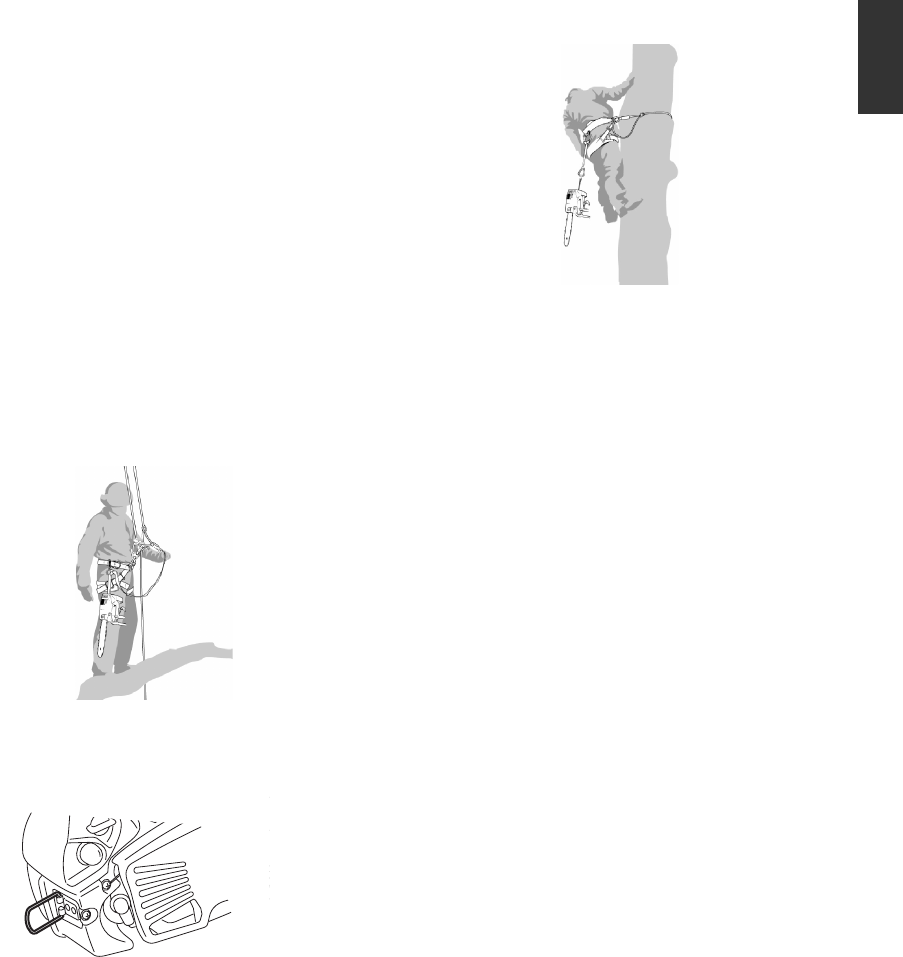
G2000T
GB-5
G
B
WORKING WITH TREE SERVICE CHAIN-SAWS
FROM A ROPE AND HARNESS
This chapter sets out working practices to reduce the
risk of injury from tree service chainsaws when working
at height from a rope and harness. While it may form
the basis of guidance and training literature, it should
not be regarded as a substitute for formal training.
General requirements working at height
Operators of tree service chainsaws working at height
from a rope and harness should never work alone. A
competent ground worker trained in appropriate emer-
gency procedures should assist them.
Operators of tree service chainsaws for this work should
be trained in general safe climbing and work position-
ing techniques and shall properly equipped with har-
nesses, ropes, strops, karabiners and other equipment
for maintaining secure and safe working positions for
both themselves and the saw.
Preparing to use the saw in the tree
The chainsaw should checked, fuelled, started and
warmed up by the ground worker before it is sent up to
the operator in the tree. The chainsaw should be fitted
with a suitable strop for attaching to the operator’s har-
ness:
a) secure the strop around the attachment point on the
rear of the saw;
b) provide suitable karabiners to allow indirect (i.e. via
the strop) and direct attachment (i.e. at the attach-
ment point on the saw) of saw to the operators har-
ness;
c) ensure the saw is securely attached when it is being
sent up to the operator;
d) ensure the saw it secured to the harness before it is
disconnected from the means of ascent.
The saw should only be attached to the recommended
attachment points on the harness. These may be at
mid-point (front or rear) or at the sides. Where possible
attaching the saw to centre rear mid-point will keep it
clear of climbing lines and support its weight centrally
down the operator’s spine.
When moving the saw from any attachment point to an-
other, operators should ensure it is secured in the new
position before releasing it from the previous attachment
point.
Using the chainsaw in the tree
An analysis of accidents with these saws during tree
service operations shows the primary cause as being
inappropriate one-handed use of the saw. In the vast
majority of accidents, operators fail to adopt a secure
work position witch allows them to hold both handles of
the saw. This results in an increased risk of injury due
to:
•not having a firm grip on the saw if it kicks back;
•a lack of control of the saw such that it is more liable
to contact climbing lines and operators body (par-
ticularly the left hand and arm)
• losing control from insecure work position resulting in
contact with the saw (unexpected movement during
operation of the saw)
Securing the work position for two-handed use
To allow the operator to hold the saw with both hands,
they should as general rule, aim for secure work posi-
tion where they are operating the saw at:
• hip level when cutting horizontal sections;
• solar plexus level when cutting vertical sections.
Where the operator is working close into vertical stems
with a low lateral forces on their work position, then a
good footing may be all that is needed to maintain a
secure work position. However as operators move away
from the stem, they will need to take steps to remove or
counteract the increasing lateral forces by, for example,
a re-direct of the main line via a supplementary anchor
point or using an adjustable strop direct from the har-
ness to a supplementary anchor point.


















